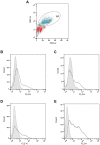Comparison of different cell culture plates for the enrichment of non-adherent human mononuclear cells
- PMID: 30867690
- PMCID: PMC6395970
- DOI: 10.3892/etm.2019.7204
Comparison of different cell culture plates for the enrichment of non-adherent human mononuclear cells
Abstract
While tissue-resident monocytes and macrophages are considered to be vital players in the in vivo interaction between biomaterials and surrounding tissue, their isolation is limited. In order to establish in vitro models elucidating implant and tissue interactions, peripheral blood mononuclear cells (PBMCs) represent a viable source for bone marrow-derived monocytes and an alternative to tissue-resident cells. The aim of present study was to analyse different adhesion-preventing tissue culture plates for their potential to facilitate the culture of monocytes without differentiation into macrophages. Freshly isolated PBMCs were seeded into four commercially available tissue culture plates with different adhesive properties and were tested for surface CD14 and CD68 expression using flow cytometry following 7 days in culture. When PBMCs were cultivated in RPMI on Cellstar® Cell culture plates with Cell-Repellent Surface, a significant increase in CD14-positive cells was observed compared with cultivation in standard tissue culture-treated plates. This was accompanied by elevated cytokine production of interleukin-6 (IL6) and interleukin-8 (IL8); however, overall cell growth was not affected. When PBMCs were pre-cultured in cell-repellent plates, there was a higher yield of adherent cells after subsequent transfer into standard tissue culture-treated plates. Cultivation of PBMCs on cell-repellent culture plates favoured a monocytic phenotype and thus, represents an alternative to increase the fraction of monocytes yielded from PBMCs.
Keywords: adhesion; differentiation; hydrophilic; hydrophobic; monocytes; peripheral blood mononuclear cells.
Figures








Similar articles
-
A protocol for rapid monocyte isolation and generation of singular human monocyte-derived dendritic cells.PLoS One. 2020 Apr 9;15(4):e0231132. doi: 10.1371/journal.pone.0231132. eCollection 2020. PLoS One. 2020. PMID: 32271804 Free PMC article.
-
Generation of dendritic cells from adherent cells of cord blood by culture with granulocyte-macrophage colony-stimulating factor, interleukin-4, and tumor necrosis factor-alpha.J Hematother Stem Cell Res. 2000 Aug;9(4):453-64. doi: 10.1089/152581600419116. J Hematother Stem Cell Res. 2000. PMID: 10982243
-
Differentiation and proliferation of endothelial progenitor cells from canine peripheral blood mononuclear cells.J Surg Res. 2005 Jun 15;126(2):193-8. doi: 10.1016/j.jss.2005.01.016. J Surg Res. 2005. PMID: 15919419
-
Negative Magnetic Sorting Preserves the Functionality of Ex Vivo Cultivated Non-Adherent Human Monocytes.Biology (Basel). 2022 Oct 27;11(11):1583. doi: 10.3390/biology11111583. Biology (Basel). 2022. PMID: 36358284 Free PMC article.
-
Spontaneous and lipopolysaccharide-induced expression of procoagulant activity by equine lung macrophages in comparison with blood monocytes and blood neutrophils.Vet Immunol Immunopathol. 1991 Sep;29(3-4):295-312. doi: 10.1016/0165-2427(91)90021-4. Vet Immunol Immunopathol. 1991. PMID: 1949591
Cited by
-
Illuminating Immunity: A Systematic Review of Immune Cell Autofluorescence.J Biophotonics. 2025 Jun;18(6):e202400576. doi: 10.1002/jbio.202400576. Epub 2025 Mar 20. J Biophotonics. 2025. PMID: 40112892 Free PMC article.
-
Combination of Interleukin-15 With a STING Agonist, ADU-S100 Analog: A Potential Immunotherapy for Prostate Cancer.Front Oncol. 2021 Mar 10;11:621550. doi: 10.3389/fonc.2021.621550. eCollection 2021. Front Oncol. 2021. PMID: 33777767 Free PMC article.
-
Mimicking of Blood Flow Results in a Distinct Functional Phenotype in Human Non-Adherent Classical Monocytes.Biology (Basel). 2021 Aug 4;10(8):748. doi: 10.3390/biology10080748. Biology (Basel). 2021. PMID: 34439980 Free PMC article.
-
How to Get Them off?-Assessment of Innovative Techniques for Generation and Detachment of Mature Osteoclasts for Biomaterial Resorption Studies.Int J Mol Sci. 2021 Jan 29;22(3):1329. doi: 10.3390/ijms22031329. Int J Mol Sci. 2021. PMID: 33572748 Free PMC article.
-
Establishment and Characterization of Free-Floating 3D Macrophage Programming Model in the Presence of Cancer Cell Spheroids.Int J Mol Sci. 2023 Jun 28;24(13):10763. doi: 10.3390/ijms241310763. Int J Mol Sci. 2023. PMID: 37445941 Free PMC article.
References
LinkOut - more resources
Full Text Sources
Other Literature Sources
Research Materials
